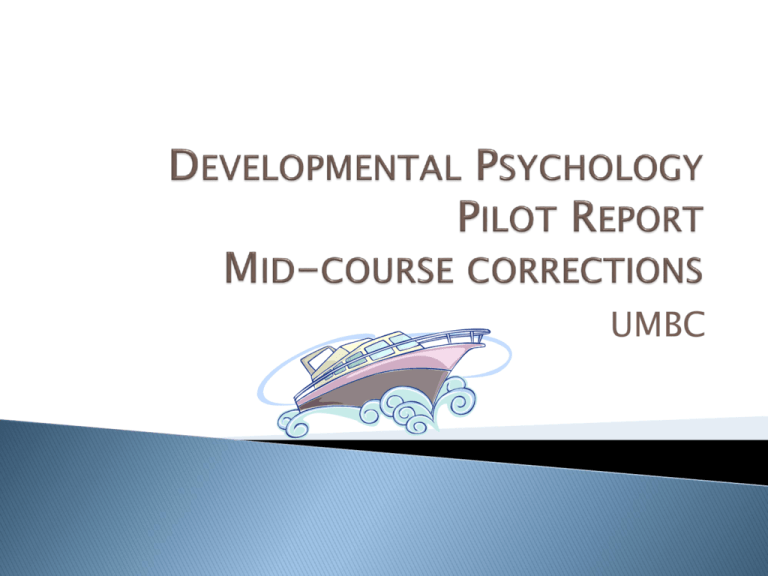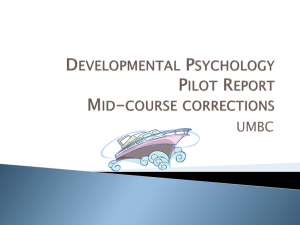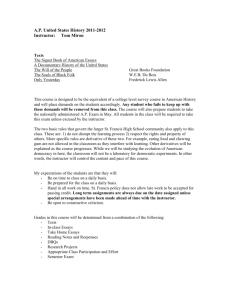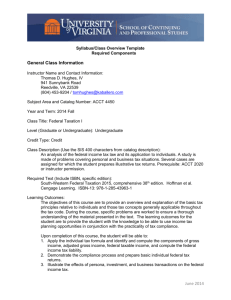Mid-Course Corrections Developmental Psychology at UMBC
advertisement

UMBC Developmental Psychology (prenatal through 12 years of age) Annual enrollment 540 students across 8 sections Required course for 4 majors; General Education Course Transfer and traditional students Lecture 2 ½ hrs a week; two sessions each week Four multiple choice exams One writing assignment Blackboard for posting No concern about DFW rates Course drift Staffing issues Poor SCEQ ratings Lack of instructional technology use Plagiarism concerns Unequal enrollment across sections (60100 students) Student requests for more application of concepts Requests for summer and winter sections Students from Shady Grove campus requesting the course (40 miles from main campus) Replacement Model Face to face sessions four times during the semester; audio lectures for each chapter Online quizzes, chapter tests, videos, and interactivities with MyDevelopmentLab Eight essays across four Units Weekly blog reflecting on topics in text Virtual child activity 1 traditional section (n=90) 1 redesign section (n=54) Same faculty assigned to both Assessment Plan ◦ Class GPA ◦ Common pretest (first 25 questions of the Final) ◦ Common final (questions agreed upon by three faculty) ◦ Student focus group at midterm ◦ Pass/fail online essays versus traditional unit essays due in class ◦ Blog quality ◦ SCEQs, item 9 re: instructor effectiveness ◦ Faculty evaluation of model impact Traditional Redesign Significance Test GPA- Mean (SD) 2.83 (0.66), N=62 2.76 (0.64), N=31 t(91)=0.50, NS Pretest scoresMean (SD) 14.84 (3.16), N=90 13.02 (3.33), N=54 t(142)=3.29, p =.001 Pretest Questions on Final ExamMean (SD) 17.41 (3.05), N=90 16.13 (3.07), N=54 t(142)=2.44, p <.05 Full Exam ScoreMean (SD) 80.08 (10.26), N=90 75.13 (10.97), N=54 t(142)=2.73, p <.01 Mean Score (Standard Error) Traditional Redesign Pretest 14.84 (0.34) Final Exam 17.41 (0.32) Pretest 13.02 (0.44) Final Exam 16.13 (0.42) Protocol 1. Students take a few minutes to answer the questions individually. 2. Students are randomly put into groups and asked to share their responses. They are asked to record only those responses for which there is consensus. 3. Debrief by having the groups report out and see how much consensus there is across groups. 4. Data is summarized for the whole class, each group, and individually. Conducted by Faculty Development Director 1. Do you usually understand what is expected of you in preparing for and participating in this class? If not, please explain why not. universal agreement-syllabus clear 2. What aspects of this course and your instructor's teaching help you learn best? media, web assignments, online tests, videos 3. What specific advice would you give to help your instructor improve your learning in this course? study guides, review sheets, more structured meetings 4. What steps could you take to improve your own learning in this course? (Share ideas from group members—agreement with others is not necessary) do not procrastinate, use the online resources, time management, attend faculty sessions GROUP QUESTIONS-TRADITIONAL 1. Do you usually understand what is expected of you in preparing for and participating in this class? If not, please explain why not. universal agreement-syllabus clear 2. What aspects of this course and your instructor's teaching help you learn best? media, videos, applied examples 3. What specific advice would you give to help your instructor improve your learning in this course? study guides, less lecturing, more activities in class 4. What steps could you take to improve your own learning in this course? (Share ideas from group members—agreement with others is not necessary) come to class, study groups Too many emails about technology issues Essay grading pass/fail took too long to review due to lack of writing skills Frustration with online miskeyed questions Students did not participate in face to face sessions Students not keeping to due dates in syllabus Enjoyed focusing on favorite content in face to face sessions More interactivity with students; learned more names Some very good comments in blogs that would not have been shared in class More flexible hours and efficient use of time Identify students needing assistance quickly Students wanted more “real-time” interaction with the instructor More structure to face to face meeting sessions Too many writing assignments; students not experienced with essay assignments Boring audio lectures; need more interaction Blog entries tended to be less scholarly Students want exam review sessions Assignment deadlines not met; posted on syllabus Faculty receiving many emails about technology glitches Videos and questions were mismatched Online tests keyed incorrectly Confusion over link to “virtual child” Student access codes incorrect; slow to register Missing data: ◦ GPA – not all available ◦ Transfer students not identified ◦ Experience with hybrid courses (technology savvy) ◦ Years at UMBC –Fr, So, Jr, Sr ◦ Reason for taking the course (major versus Gen Ed) ◦ Repeat enrollment not identified ◦ Difference between night class students and day class students? Instructor had virtual office hours once a week; students signed up for sessions and identified topics. Increased to six face to face meetings and pedagogy change to group assignments related to unit content. (2 ½ hr sessions) Reduced writing assignments to four (pilot had six) with grading rubric embedded in the assignment. Added online resource for writing assistance Moved to discussion board with required scholarly postings; examples provided. Notification of due dates and times set on HOME Bb page Publishers completed all “fixes” by mid January. One link to the “virtual child” was embedded in Bb. Student access codes were corrected Deleted audio lectures and provided study guides with key concepts; added supplemental resources more interactivities TA trained in technology and completed an orientation with students Online orientation package was developed for use of virtual child and MyDevelopmentLab Office of Institutional Research working on identifying missing data Information sheet developed for missing OIR data IMPLEMENTATION DATA






